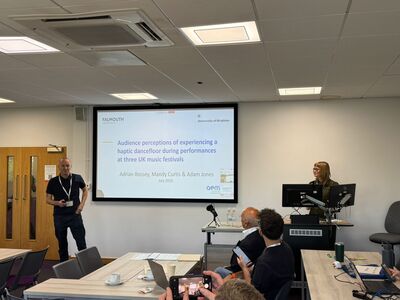Bossey, Adrian  ORCID: https://orcid.org/0000-0002-9874-6323, Curtis, Mandy and Jones, Adam
(2025)
Audience perceptions of experiencing a haptic dancefloor during performances at two UK music festivals.
In: AEME Forum 2025, 2-3 July 2025, University of Chester.
ORCID: https://orcid.org/0000-0002-9874-6323, Curtis, Mandy and Jones, Adam
(2025)
Audience perceptions of experiencing a haptic dancefloor during performances at two UK music festivals.
In: AEME Forum 2025, 2-3 July 2025, University of Chester.
|
Text (AEME Abstract)
AB MC AJ - Abstract for AEME Forum 25.doc - Accepted Version Available under License Creative Commons Attribution. Download (76kB) |
|
Preview |
Slideshow (AEME 2025 Presentation)
AEME 25 AB MC AJ Haptic Floor FINAL.pdf - Published Version Available under License Creative Commons Attribution. Download (5MB) | Preview |
![[thumbnail of Adrian Bossey and Mandy Curtis presenting at AEME2025]](https://repository.falmouth.ac.uk/6102/4.hassmallThumbnailVersion/Adrian%20Bossey%20and%20Mandy%20Curtis%20presenting%20at%20AEME2025.jpeg)  Preview |
Image (Adrian Bossey and Mandy Curtis presenting at AEME2025)
Adrian Bossey and Mandy Curtis presenting at AEME2025.jpeg - Supplemental Material Available under License Creative Commons Attribution. Download (305kB) | Preview |
Abstract / Summary
In 2020/21, twenty four percent of the UK population had a disability (House of Commons Library 2022:1) however, the UK live music industry does not fully address accessibility for people who are d/Deaf, disabled or neurodiverse. ICT comprises equipment and resources used to “transmit, store, create, share or exchange information” (UNESCO 2023:1) wherein haptic technologies relate to the sense of touch. The Live Audience Accessibility & Augmentation 2 Beat Blocks (‘LAAA2BB’) project evaluated user experience/perceptions of the authenticity of their live experience when experiencing the BEAT BLOCKS multi-sensory interactive flooring system which turns sound into felt vibrations at selected music festivals. LAAA2BB aims to measure audience perceptions of experiencing haptics on-site at 2 festival sites: Cheltenham Jazz Festival, and Tropical Pressure in Cornwall, with the objective of supporting opportunities to promote greater accessibility through the utilisation of ICT. The LAAA2BB project built on the previous LAAA projects one of which was funded by AEME.
The study employed a participatory research (PAR) approach, recognised as a suitable and effective method for qualitative social research to understand the lived experience of participants who are d/Deaf, disabled or neurodivergent. (PAR) involves reflection, data collection, and people-centred action. The research methods consisted of photo elicitation, followed by the co-construction of knowledge through interviews through discussion and analysis of the photos and videos. The interview phase occurred immediately after the haptic technology experience. The research approach empowered participants to utilise a three-stage narrative process, to explore the meaning of their photo elicitation in relation to their personal experience of authentic 'live' music performances augmented with haptic technology.
This presentation will incorporate images of the field research. It will evaluate the field research process, sharing the challenges involved. The results and conclusions from the data collection process will be presented, alongside recommendations regarding future opportunities for researchers and industry practitioners. The presentation responds directly to the Forum theme of ‘Events in the digital landscape’, as well as the sub-themes of hybrid events, inclusivity in digital events and events & technology.
| Item Type: | Conference or Workshop Item (Other) |
|---|---|
| Uncontrolled Keywords: | Liveness, haptics, accessibility, music festivals |
| Subjects: | Business > Experience Design Business > Leisure & Tourism Business > Management |
| Department: | Cornwall Business School |
| Depositing User: | Adrian Bossey |
| Date Deposited: | 07 Jul 2025 14:29 |
| Last Modified: | 07 Jul 2025 14:29 |
| URI: | https://repository.falmouth.ac.uk/id/eprint/6102 |
 |
View Record (staff only) |

 Advanced Search
Advanced Search Tools
Tools Tools
Tools